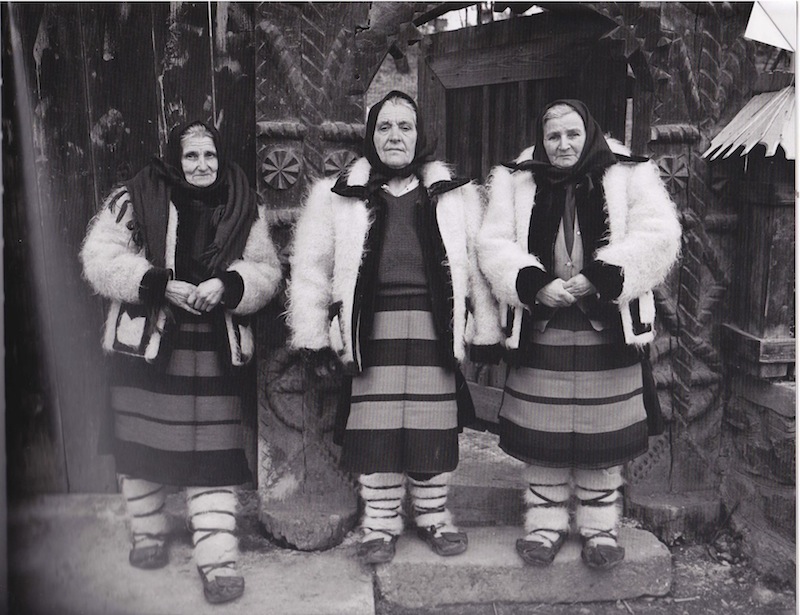
The Color of Hay
The Peasants of Maramures
Kathleen Laraía McLaughlin
H. Woods McLaughlin
(H L Books)

Kathleen and H. Woods McLaughlin actually did something that you and I have been thinking of doing all these years. They took off for eastern Europe and ended up in an old village in the mountains --- one that had hardly been touched by the modern world. They moved in for a couple of years, living with a family in a cottage, doing as the simple folk did --- no air conditioners or cars or televisions or computers, avoiding all those things we use to keep ourselves from reminding ourselves that there are other ways to live on the earth, a living with the earth rather than living by stealing the earth. The McLaughlins "went native," as we used to say.They picked a place that was in their blood... a place where their grandfathers and grandmothers had grown up in years and years ago, a rural spot in the Carpathian regian of north central Romania. They took a camera and some clothes and little else, got invited to move in with a family --- father, mother, children, grandmother --- but no hot showers, no telephone, no electric blankets. They lived the same primitive life as the subjects of this book, and we judge that the two of them lived as unobtrusively as possible, intent on catching the substance of the lives of these people "connected to the earth," in a place of "peace and simplicity."
They knew --- as do the folk of Oena, Valent, Mara, Sirbi, and Glod (no kidding: Glod!) --- that they had come to record a life-style that had existed for centuries, that was fading, and fading quickly. The young folk were not interested in bringing in the hay, harvesting corn, slaughtering the animals, hovering over a fire in the winter, working in dust-blown fields during the summers, spending three days brewing up plum wine for the occasional wedding and festival. The kids are heading out: those who were born at the time of the end of Communist rule in Transylvania were now moving along to Bucharest or even further, with their cellphones and telephones ... all harbingers of the doom of their parents' ancient and honorable way of life. Their families even have a song that says that when one heads over the mountains, "we shall never see you again."
Given the fact that Romania has now applied for and been granted a place in the European Union, all will turn strange in these valleys. "The neatly manicured landscape will change as fields become fallow. Tidy plots will become overgrown or consolidated. The very landscape will begin to shift and appear more like rural areas elsewhere."
This is the way of change we have built into our modern world, which will finally accomplish what the Romans, Turks, and Hungarians never could: complete transformation of the Maramures valleys.
This is a hefty book, a book of love and reminiscence. These folk, however, are in no way over-romanticized, nor are their ways painted as lovely, gentle, all wise, all good. There are harsh winters, along with dirt and blood and sweat. The authors are not here to prettify it, they are certainly not ethnologists nor cultural sociologists. They are a couple with a camera and a fine sense of form and grace and a love of the past. Somehow they brought into being a great volume --- forty-four color photographs, ninety-four black-and white pictures --- spread out full page. There's no wasted commentary, only a fine tribute to peoples who are immersed in a change that no one seems to want.
The volume is divided into a dozen or so chapters (Spring, Winter, Autumn, Home, Clothes, Food, The Ceremonies of Life, Marriage, Old Age, Death) and the photographs are displayed just as they should be: simple, direct, unflinching, the people in their funny hats that look like tiny upside-down baskets, the women in their kerchiefs, the local band --- violin, accordian, beat-up drum slung around the shoulder --- people in the open air market with their bloody just-killed lambs, old folk out in the fields building enormous haystacks, hauling 70-kilo bags of corn, working the icy whirlpool of the river to wash their heavy clothes and blankets, three women standing in their white thick woolen bootlets.
The whole of Color of Hay has a rich, sensitive form. The 150 photographs appear at the end reproduced in miniature with appropriate explanations. This picture of "Petru from Gold, 2000" is one of an old man, his hat tilted down, clean white shirt, steady look, no nonsense, workboots there in the background,
People seem to grow old quickly here, yet at the same time, they grow old with grace. Many times a man of eighty will appear as only sixty.
We asked them how they look so good.
"The air is clean," they say. "And our land is blessed."
Woods McLaughlin is no slouch in the writing department. In the chapter on animals he notes,
If one imagines the barnyard as a hierarchy of privilege to live according to one's animal impulses, the clear winner is the household cat. Through millennia of living with humans, cats have made the fewest compromises. We provide them a barn yard of mice, protection from predators, and regular bonus meals --- in return for which they lead their lives as they would anyway: sleeping eighty percent of the time and playing with their food.
Roosters and hens occupy the next step down the list. They get the cat's protection from predators, but with the disadvantage of occasionally becoming soup.
--- Geraldine Grace, M. A.